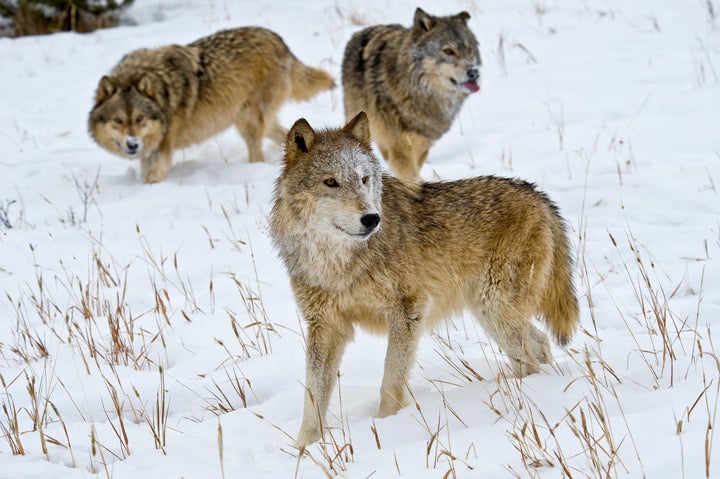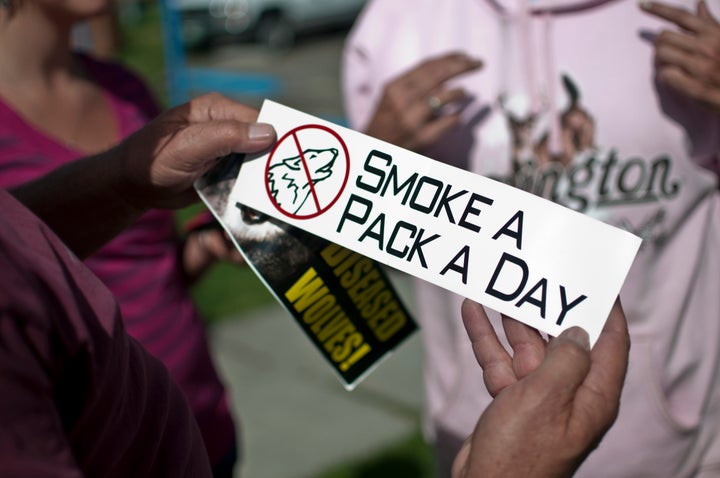Idaho and Montana both passed controversial laws last year with the goal of sharply reducing their gray wolf populations. The Idaho law gained national attention over reports that the state aimed to eradicate up to 90% of its gray wolves.
If that's the plan, it hasn’t worked yet.
The number of gray wolves killed by hunters and trappers fell within the ranges documented for the last few years, according to data released by both states last week. Neither state showed an unusual spike in wolf deaths.
In Montana, hunters and trappers have killed 189 wolves since the 2021-22 wolf-hunting season began — about average for this time of year. Idaho documented 300 wolf deaths by the end of December. That figure, which includes natural mortality and wolves killed for livestock predation, is higher than it was at the same time a year prior, but lower than in 2019.
Idaho’s gray wolf population stood at 1,543 as of Aug. 1, according to a state estimate based on computer analysis of millions of trail camera images — about two dozen fewer wolves than at the same time in 2019.
“We don’t know where it’s going to end up,” Idaho Fish and Game spokesperson Roger Phillips said. “There’s still plenty of hunting and trapping season out there. But so far, we’re not seeing it tracking differently than it has for previous years.”
The Idaho legislature caused a major uproar last year by passing a law slashing restrictions on the state’s already-liberal regulations for hunting and trapping wolves. Hunters and trappers may now legally kill an unlimited number of wolves. They can hunt wolves at night and while using motor vehicles. The law allows the contracting of third parties to target wolves.
Former wildlife officials criticized the legislature for usurping wildlife management from state agencies, while environmentalist and animal rights groups decried the law as an open wolf slaughter and urged the U.S. Fish and Wildlife Service to put wolves in the Northern Rockies back under the protection of the Endangered Species Act.
Montana also passed laws targeting wolves last year, though legislators left the state’s Fish, Wildlife and Parks agency largely in charge of regulating the wolf harvest, eliminating one of the Idaho law’s most contentious elements.

Ranchers championed the Idaho bill, saying the growing wolf population was eating into their bottom line.
Wolves kill only a small number of domestic cows each year. But in areas where they are present in large numbers, they tend to push and stress cattle herds, delaying their weight gain. Profit in cattle ranching depends on moving the livestock from birth- to slaughter-weight quickly.
Nothing in the Idaho law specifies how many or what percentage of wolves hunters and trappers should kill.
But Idaho agreed to maintain a minimum of 150 wolves when the federal government delisted wolves in the Northern Rockies from the Endangered Species Act. Critics who said the Idaho bill would result in the killing of 90% of the state’s wolves came up with that number by reasoning that 150 is 10% of the state’s total wolf population of 1,500.
It takes more than legal changes, however, to kill that many wolves. Both states had already made it cheap for people to buy lots of the tags they needed to hunt or trap wolves, over lengthy seasons, especially on private land.
But wolves roam huge swaths of unpopulated land in those states. They routinely cover distances of 20 miles, mostly at night. And the fur market doesn’t offer prices high enough to motivate significant numbers of people to specialize in trapping wolves. The result is that the vast majority of people who buy a tag allowing them to kill a wolf never fill it.
While the Idaho law hasn’t yet decimated its wolf population, some of its backers view it as a minor victory that the state’s estimate shows the wolf population dropped by about two dozen in the last two years, after a period of rapid growth.
“We are grateful to see that it’s declining slightly,” said Chyla Wilson, a spokesperson for the Idaho Farm Bureau Federation, a major backer of the wolf bill. “It will be interesting to see where it goes in the next couple of years. We obviously don’t think the population will go down a substantial amount ― not even close to 90%. But we do want to see a slow decrease to reduce conflicts.”
Last week’s numbers add a new dimension to the rekindled debate over whether the federal government should protect gray wolves in the Northern Rockies under the Endangered Species Act. USFWS is considering an emergency listing for gray wolves in Idaho and Montana, but will not likely rule for several months.
Some suspect that the laws’ full effects remain unknown, partly due to harsh winter weather that might have kept some hunters and trappers from the field.
“It’s extremely early to estimate how many wolves are going to be killed with these new laws in place,” said Andrea Zaccardi, a lawyer with the Center for Biological Diversity. “The wolf killing numbers are still extremely high. They were high before these laws and I think they’ll remain high and even be higher.”

While Montana’s overall wolf population didn’t nosedive, the new laws profoundly affected wolf populations near Yellowstone National Park.
Montana wildlife officials had previously imposed a hunting quota of one wolf in each of the two hunting units where most of the park’s wolves have historically gotten killed. After the legal changes, the state replaced the unit-based quotas with a region-wide target of 82 wolves.
That change hammered Yellowstone wolves. Hunters and trappers killed a total of 23 wolves on Yellowstone’s borders, reducing the park’s wolf population by 20% and eliminating one of its packs.
Montana’s wildlife commission voted 7-0 on Friday to keep the hunting season open until meeting the 82-wolf threshold, over the objections of Yellowstone National Park Superintendent Cameron Sholly.
Montana Gov. Greg Gianforte (R) also killed a Yellowstone wolf in February of last year, though that was before the legal changes and before the current hunting and trapping season began. Gianforte received a reprimand from a state agency he oversees for failing to complete a required course before doing so.
A combination of commercialized hunting and government poisoning campaigns to protect livestock eradicated gray wolves from the West by the early 20th century. Yellowstone National Park served as the main site of their reintroduction to the Northern Rockies in 1995.
The park does not permit hunting, and wolves have flourished there. Visitors hope to see them, and people have followed the wolves’ lives from afar through the animals’ biologist-assigned numbers.
Park officials called the wolf deaths “a significant setback for the species’ long-term viability and for wolf research” in a statement to The Associated Press.

